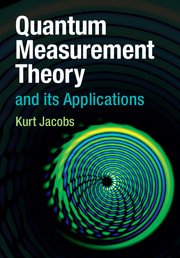Book contents
- Frontmatter
- Dedication
- Contents
- Preface
- 1 Quantum measurement theory
- 2 Useful concepts from information theory
- 3 Continuous measurement
- 4 Statistical mechanics, open systems, and measurement
- 5 Quantum feedback control
- 6 Metrology
- 7 Quantum mesoscopic systems I: circuits and measurements
- 8 Quantum mesoscopic systems II: measurement and control
- Appendix A The tensor product and partial trace
- Appendix B A fast-track introduction for experimentalists
- Appendix C A quick introduction to Ito calculus
- Appendix D Operators for qubits and modes
- Appendix E Dictionary of measurements
- Appendix F Input–output theory
- Appendix G Various formulae and techniques
- Appendix H Some proofs and derivations
- References
- Index
Appendix A - The tensor product and partial trace
Published online by Cambridge University Press: 05 September 2014
- Frontmatter
- Dedication
- Contents
- Preface
- 1 Quantum measurement theory
- 2 Useful concepts from information theory
- 3 Continuous measurement
- 4 Statistical mechanics, open systems, and measurement
- 5 Quantum feedback control
- 6 Metrology
- 7 Quantum mesoscopic systems I: circuits and measurements
- 8 Quantum mesoscopic systems II: measurement and control
- Appendix A The tensor product and partial trace
- Appendix B A fast-track introduction for experimentalists
- Appendix C A quick introduction to Ito calculus
- Appendix D Operators for qubits and modes
- Appendix E Dictionary of measurements
- Appendix F Input–output theory
- Appendix G Various formulae and techniques
- Appendix H Some proofs and derivations
- References
- Index
Summary
Combining two systems: the tensor product
The state of a quantum system is a vector in a complex vector space. (Technically, if the dimension of the vector space is infinite, then it is a separable Hilbert space.) Here we will always assume that our systems are finite-dimensional. We do this because everything we will discuss transfers without change to infinite-dimensional systems. Further, when one actually simulates a system on a computer, one must always truncate an infinite-dimensional space so that it is finite.
Consider two separate quantum systems. Now consider the fact that if we take them together, then we should be able to describe them as one big quantum system. That is, instead of describing them by two separate state vectors, one for each system, we should be able to represent the states of both of them together using one single state vector. (This state vector will naturally need to have more elements in it than the separate state-vectors for each of the systems, and we will work out exactly how many below.) In fact, in order to describe a situation in which the two systems have affected each other – by interacting in some way – and have become correlated with each other as a result of this interaction, we will need to go beyond using a separate state vector for each. If each system is in a pure state, described by a state vector for it alone, then there are no correlations between the two systems. Using a single state vector to describe the joint state of the two systems is the natural way to describe all possible states that the two systems could be in (correlated or uncorrelated). We now show how this is done.
- Type
- Chapter
- Information
- Quantum Measurement Theory and its Applications , pp. 432 - 440Publisher: Cambridge University PressPrint publication year: 2014
- 1
- Cited by



